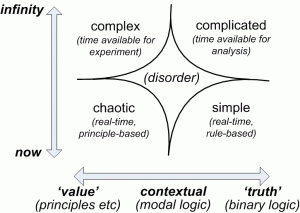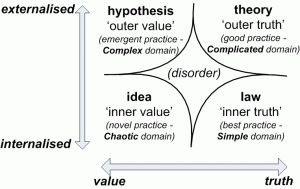Using ‘Cynefin-like’ cross-maps (‘Beyond-Cynefin’ series)
(This is part of an ongoing series that explores alternate uses of a generic conceptual categorisation originally described in the well-known Cynefin diagram. It should be emphasised that this discussion is not about the Cynefin Framework, which is a distinct body of practices based on scientific research. For details on the definition and use of the Cynefin framework proper, please contact Dave Snowden at Cognitive Edge. As this broader usage of the categorisation does not yet have a specific name, the term ‘beyond-Cynefin’ is here used solely as a temporary placeholder to indicate this separation of interests.)
‘Cynefin-like’ cross-maps
I first started using what we could describe as ‘Cynefin-like’ models several decades ago, such as in my book Inventing Reality (first published 1986, current print-edition available here). I’ve found them immensely valuable in a very wide range of applications, especially in disciplines such as enterprise-architecture that necessarily cover the entire scope of a context. The key to its usefulness is that the model’s categorisation provides a consistent base-map for all manner of cross-maps, each of which provides new insights about the context.
Typical characteristics of a ‘Cynefin-style’ base-map include:
- universality: the model purports to cover the entire scope of a given context
- sensemaking: the purpose of the model is to guide sensemaking and decision-support, rather than (for example) design and implementation of a specific ‘solution’
- simple partitioning: the model divides the context into a small number (typically 4-5) of regions or ‘domains’ (e.g. the Cynefin set of ‘Simple’, ‘Complicated’, ‘Complex’ and ‘Chaotic’), and often including a ‘none-of-the-above’ region (e.g. the Cynefin central region of ‘Disorder’)
- fluid boundaries: the boundaries between regions are not rigidly fixed (as they are in e.g. a two-axis matrix), and may be allowed to move, blur and/or be somewhat porous
- usage-dependent layout: the layout of the model may not be semantically significant (as it is in e.g. a two-axis matrix) – layouts are often two-dimensional, but may be single-dimension horizontal or vertical, or multi-dimensional such as the four-axis/three-dimension tetradian
(More after the ‘Read more…’ link.)
Cynefin-categorisation as cross-map base-frame
The Cynefin categorisation provides one of the most useful base-frames for cross-maps in sensemaking:
- Simple: perceived cause-effect linkage is linear and direct
- Complicated: perceived relationship between cause and effect is linear but ‘complicated’ (though note that in this domain the term ‘complex’ is often misused as a synonym for ‘very complicated’)
- Complex: ’cause’ and ‘effect’ are intertwined and interdependent (e.g. an ‘effect’ becomes part of input to its own ’cause’ in the next iteration)
- Chaotic: no discernible cause-effect relationships
- Disorder: ‘none-of-the-above’ region, before cause-effect categorisation has taken place
The ‘Cynefin diagram’ on Wikipedia provides one such example of a cross-map for sensemaking:
This shows two cross-maps on the base-frame:
- typical tactics to use where the respective cause-effect conditions apply (e.g. ‘P-S-R’ (‘probe > sense > respond’) for ‘Complex’ causality)
- common terms for the overall practice in which such tactics are used
Using these and other specific cross-maps, which are further cross-linked to “research into complex adaptive systems theory, cognitive science, anthropology and narrative patterns”, the Cynefin framework “proposes new approaches to communication, decision-making, policy-making and knowledge management in complex social environments”. The term ‘Cynefin’ should only be used in relation to this formal Cynefin framework.
However, there are many other potentially-useful cross-maps that rely on the same base-frame, or a very similar base-frame. To reduce the risk of confusion, I’ll use the term ‘Cynefin-like’ from now on to describe such cross-maps.
The remainder of this post describes two particularly useful Cynefin-like cross-maps; I’ll describe others in subsequent posts. In most cases I’ll use the same layout as for the standard Cynefin diagram, so as to make it easier to cross-map between any of the cross-maps shown.
Timescale versus ‘bindedness’
This cross-map is particularly useful in enterprise-architecture and business-architecture. It’s also an example where the borders between the regions blur in both directions, because each of the axes is a continuous spectrum rather than a simple binary division.

Where time is more available for analysis or experiment, modal-logic can provide a useful bridge between binary true/false logic and principle-based decision-making. (One simple modal-logic set often used for contextual decision-making in enterprise-architecture reference-models is ‘shall’ versus ‘should’, ‘could’ and ‘is an option known to work’, also related to the MoSCoW priorities in Agile development.)
However, the closer we get to real-time, the more our understanding of cause-effect relationships in the context forces us into a near-binary decision: if rule-based decision-making will work, use those rules, otherwise fall back towards principle-based decision-making. This means that wherever rule-based (low-skill) decision-making becomes unreliable within the context, we must have a principle-based (i.e. high-skill) capability to fall back to.
Development of embodied ‘best practice’
This cross-map draws on Jungian concepts, yet is also a further cross-map with the Cynefin diagram’s types of practice. This is particularly useful for sensemaking in skills-development and in implementation of innovation.

This also again cross-maps to the previous example, in terms of available time. Initial ‘useful ideas’ need sufficient time to develop hypotheses for reflection, experiment and test, and further refinement into theory, which will usually anchor it into a conventional linear (true/false) cause-effect logic. This then either becomes enshrined as ‘law’ or ‘best practice’, or (in skills-development) literally embodied through repeated practice such that the action can become automatic response available for use in real-time skills-implementation.
In effect, there is a ‘clockwise’ pattern or pathway here traversing through the conceptual space of the cross-map, a cycle of continuous innovation. (As will be seen in another post, the well-known PDCA practice-improvement cycle actually goes in almost the opposite direction.) One of the real dangers that this highlights is that the ‘law’ domain is often regarded as a final destination, an apparent guarantee of certainty. In reality this ‘finality’ is actually spurious and misleading – as is indicated by the fact that ‘law’ is a single region of the conceptual-space here, not the whole of the space. Wherever this notion becomes dominant, the boundary between ‘law’ and ‘idea’ will often become near-absolute, preventing further innovation even when necessary. In practice, in such cases, innovation becomes possible only via a transit through the region of ‘disorder’ – which in a business context, for example, can sometimes be ‘disruptive’ in just about every possible sense…
Will stop there for now: more cross-maps to follow. Hope this is useful, anyway.
Previous posts in this series:

Hi Tom, many thanks for this post; I am following this concept since I have seen it in your book “Every day enterprise Architecture”.
* Could you please show me a clear example on how this could be useful for the Enterprise Architecture?
* what are the decisions I can get as an EA architect from using this model?
* Also, can we establish a connection between the 4-domains defined as part of the model and the viewpoints / artifacts to be produced as part of the EA?
regards,
Hi Ahmed – many thanks for this.
Before answering your questions, I perhaps ought to emphasise that the connection with Cynefin is now solely historical, not least because there were very strong objections from Snowden to any use of crossmaps with Cynefin. For this purpose here it’s essentially been replaced by SCAN (see post ‘Metaframeworks in practice, Part 4: Context-space mapping and SCAN‘).
Examples of how this can be used in enterprise-architecture: Probably the simplest is to look through the blog-posts here that reference SCAN – there are more than 50 of them now, many showing various cross-maps to illustrate themes in EA. On the Open Group weblog, Stuart Boardman shows another practical application in his post ‘Variety, Black Swans and Platform 3.0‘.
Derived decisions: One key decision is in identifying what is automatable (Simple, Complicated) and what is probably not (Ambiguous, Not-known). See my IASA slidedeck ‘Backbone and edge‘ for how to use SCAN crossmaps to select appropriate governance-methods for ‘backbone-IT’ and ‘shadow-IT’. And see slides 96-100 in my Open Group slidedeck ‘Same and different‘ for a worked-example of probability-maps and derived design-decisions in a healthcare-context.
Connection between 4-domains and EA-viewpoints: To me, I’d say there’s no mandatory connection there: any crossmap we derive there would need to be interpreted solely in terms of whether or not it’s useful for design-decisions and suchlike, rather than as an assertion of ‘truth’. For example, there’s a potentially-useful crossmap in terms of SCAN-domain :: Archimate-layer :: decision-method as follows:
But it’s really important to note that that crossmap is not a ‘truth’ – merely something that might be useful in making sense of a context (‘sensemaking’) and in guiding subsequent decisions (‘decisionmaking’).
Hope this helps? – and perhaps let me know if you’d like me to expand this out to a more detailed blog-post.